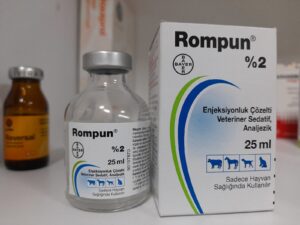Warning: Some links/references may contain graphic medical images.
Over 130 people die daily from opioid overdose. The rates of overdose deaths have skyrocketed in the last decade, largely due to the popularity of synthetic opioids like fentanyl. How can it get worse?

Tranq dope. Anestecia de caballo. Xylazine. Recent media has been all over this “new” drug popping up in communities across the east coast. But what is the real story? In the age of misinformation, it can be hard to know what to believe. In fact, when it comes to xylazine many physicians don’t yet know what to believe. Despite being found in the drug supply in Puerto Rico and several east coast cities for decades, little to no research has been conducted on xylazine. I am here to catch you up on what we know, and don’t know, about this latest public health crisis.
First, what is xylazine? Xylazine, sold under name brands like Rompun® or XylaMed™, is a veterinary sedative that is often used in horses and various farm animals or pets. Scientists have previously been more interested in how it could aid in anesthesia as it is also used in biomedical research in combination with ketamine (another veterinary drug) to sedate rodents for surgical procedures. Due to its frequent use in combination with ketamine, only a handful of studies look at xylazine alone.
This gap in knowledge has become a much bigger problem in recent years as Philadelphia has seen more and more xylazine involved in opioid overdose deaths. Fentanyl overdoses are regularly treated with naloxone (an opioid reversal agent). Physicians fear that xylazine will make naloxone less effective at reversing respiratory depression, the cause of death in overdoses. Not only is there fear that it can make fentanyl even more deadly, people are developing lesions from drugs containing xylazine. Unfortunately, scientists and physicians are not sure what exactly causes these lesions, or how to best treat them. Another danger is making assumptions about the effects of xylazine. We do not know how xylazine actually alters the fentanyl experience. We only have anecdotal evidence at this point. As with any drug, there is likely a wide range of possible responses across different people. Some people report that their highs are more intense with fentanyl that contains xylazine. Some report that it knocks them unconscious for days. Some people barely notice a difference. Some people never develop lesions from their xylazine, and others have had lesions so severe they have had a limb amputated.
What can we do about xylazine right now?
The biggest medical concern is that xylazine might worsen the respiratory depression caused by fentanyl. This is possible given that both xylazine and fentanyl are sedative at certain doses and used in anesthesia. While opioid- induced respiratory depression is thought to be caused by the mu opioid receptor, xylazine might still exacerbate fentanyl’s effects here. Opioid overdoses involving xylazine have been on the rise in recent years. These numbers are anticipated to continue to rise as xylazine further infiltrates the illicit drug supply. Research is needed to understand how these two drugs interact and whether or not naloxone will still effectively reverse overdoses.
Much of the media coverage contains disturbing images and concerning language. For example, many headlines have taken to calling xylazine the “zombie drug”. Language that likens those with substance use disorders to zombies is problematic since it can create an environment devoid of empathy and full of blame. As this health crisis continues to unfold, it is crucial to use appropriate language to discuss the issues at hand (for patient-centric language, please refer to the National Institute on Drug Abuse website).
We can make an impact right now, as scientists, by making sure that the appropriate experiments are being run to inform public health and medical professionals. We need to understand the interactions between opioids and xylazine, identifying potential risk factors and mechanisms that lead to overdose. As citizens, it is important to educate ourselves and keep an eye out for claims made without any scientific backing. We can also increase community awareness of support networks, encourage responsible opioid use, and harm reduction tactics. Further, be careful of the language we use to discuss the opioid epidemic and substance use disorders in general! Together, these actions could help lead us towards safer, healthier communities.
For additional resources please see:
UNC Street Drug Analysis Lab (anonymous drug testing)
GettingOff Right (safety manual fo people who inject drugs)
1-800-484-3731, National Overdose Prevention Lifeline
National Harm Reduction Coalition
Peer editor: Maria X. Cardenas